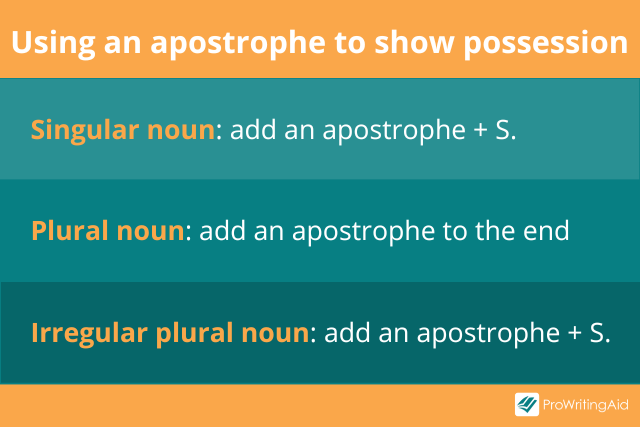As a writer, I’ve often found myself wrestling with the seemingly simple question: “Is it ‘the dog’s bone’ or ‘the dogs’ bone’?” It’s a common grammatical conundrum that trips up even seasoned writers. The difference between “apostrophe s” and “s apostrophe” might seem subtle, but it’s crucial to understanding the nuances of English grammar. Let’s delve into the world of possessive nouns and unravel this grammatical puzzle.

Image: quizlet.com
Whether you’re a student crafting an essay, a professional writing a business report, or simply someone who wants to communicate clearly, comprehending the rules of possessive nouns is essential. In the following guide, we break down the principles behind using apostrophes for possession and help you conquer this common grammar challenge.
Understanding Possession: A Fundamental Rule
The primary function of the apostrophe in English is to signal possession. It tells us that something belongs to someone or something else. This concept of ownership is crucial to understanding the difference between “apostrophe s” and “s apostrophe.” The apostrophe is the key to unlocking the mystery.
To illustrate the concept, let’s take a simple example. If we want to say that the bone belongs to the dog, we would write “the dog’s bone.” The apostrophe followed by “s” signifies that the bone is owned by the dog. This is the standard form for possessive nouns in English.
The “Apostrophe S” vs. “S Apostrophe” Dilemma
“Apostrophe S” For Singular Possessives
The most common form of the possessive is the “apostrophe s.” This is used for singular nouns and for plural nouns that do not end in “s”, like “children.” For example:
- The dog’s tail wagged excitedly. (Singular noun)
- The child’s laughter filled the air. (Singular noun)
- The children’s toys were scattered around the room. (Plural noun not ending in “s”)

Image: prowritingaid.com
“S Apostrophe” For Plural Possessive Nouns
When we have a plural noun that ends in “s”, the possessive form is created by adding just an apostrophe after the “s.” This is known as the “s apostrophe” form.
- The dogs’ barks echoed through the park. (Plural noun ending in “s”)
- The students’ grades were posted on the bulletin board. (Plural noun ending in “s”)
Exceptions to the Rules
As with many aspects of grammar, there are a few exceptions to keep in mind.
- Proper Nouns: For proper nouns ending in “s,” it’s generally acceptable to use either “apostrophe s” or “s apostrophe.” For example, “Charles’s” or “Charles’ ” are both correct.
- Joint Possession: When two or more nouns possess something jointly, the apostrophe goes only after the last noun. For example, “John and Mary’s house”.
- Separate Possession: If two or more nouns possess something individually, the apostrophe is added after each noun. For example: “My parents’ cars” (each parent has their own car).
Practical Tips for Perfect Possessives
Mastering the usage of “apostrophe s” and “s apostrophe” can feel daunting, but it becomes easier with practice. Here are some tips to help you get it right:
- Identify the owner: Who or what possesses the object in question? This will determine if it’s a singular or plural noun.
- Determine plurality: Is the owner singular or plural? If it’s singular, use “apostrophe s.” If it’s plural and ends in “s,” use “s apostrophe.”
- Practice, practice, practice: The key to mastering any grammar rule is consistent practice. Read widely and pay attention to how possessives are used in the writing you encounter.
FAQ: Demystifying the Apostrophe
Q: How do I know when to use “its” and “it’s”?
A: Remember that “its” is a possessive pronoun (“the cat licked its paw”) and “it’s” is a contraction of “it is.”
Q: When do I use “whose” and “who’s”?
A: “Whose” is the possessive form of “who.” (“Whose book is this?”) “Who’s” is a contraction of “who is” or “who has.” (“Who’s going to the party?”)
Q: Can I use “apostrophe s” for inanimate objects?
A: Yes, you can use “apostrophe s” for inanimate objects. For example, “the car’s engine.” However, it’s often more natural to avoid the possessive form and use a different construction, such as “the engine of the car.”
Q: Is it ever okay to use apostrophes for plural nouns without possessives?
A: It’s generally not okay to use apostrophes for plural nouns without possessives. For example, “1980s” is correct, while “1980’s” is incorrect.
Difference Between Apostrophe S And S Apostrophe
https://youtube.com/watch?v=S5ZKuWcdKNQ
Let’s Recap and Take Action
The difference between “apostrophe s” and “s apostrophe” might seem small, but it’s essential for clear and accurate communication. By understanding the rules of possessives, you can ensure that your writing is grammatically correct and easy to understand.
Are you feeling confident about using possessive nouns in your own writing? We hope this guide has empowered you to conquer this common grammar challenge. Let us know your thoughts in the comments section below!






